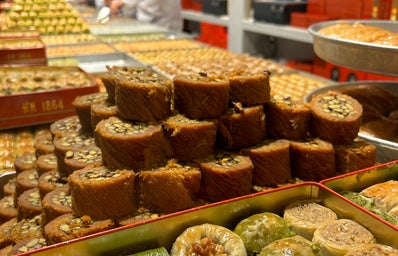Turkish cuisine offers a diverse blend of flavours that will leave you craving more. The tastes, textures, and aromas reflect the country’s rich history, geography, and culture.
There are many dishes offered, like savoury meats and delicious sweets. Locals in Turkey take a lot of pride in their meals as it’s a big part of the country’s tradition and strong patriotic community, and also puts the country on the map for its cuisine.
Where did it all start?
Turkish cuisine is deeply rooted in the country’s history. Spanning from ancient times to the Ottoman Empire and now in the present day, the cuisine draws inspiration from all corners of the earth, including Central Asia, the Middle East, the Balkans, and the Mediterranean.
Some staples in the Turkish diet are yogurt (labneh), olives, dates, spices, pastries, and kebabs (kebap).
Signature Dishes
Kebabs
Perhaps the most iconic Turkish dish, kebabs come in various flavours and forms.
The Adana Kebab is named after the city of Adana, which I visited during my trip to Turkey. Meat shops fill the city, and a kind gentleman suggested I try this flavour. This kebab was marinated using authentic spices minced into lamb meat and tail fat.
Meanwhile, the classic shish kebab consists of skewered grilled meat. You can find this dish everywhere, from fancy restaurants to street stalls.
Mezes
Authentic Turkish meals typically begin with a spread of mezes — small appetizers eaten before the main meal. Mezes are a way to showcase an array of flavours. They often consist of dolma (stuffed grape leaves), fresh pita, eggplant salad, hummus (chickpea dip), and labneh (Turkish yogurt).
Did you know the tradition of mezes became popular during the Ottoman Empire when the sultan (the king) would request a grand meal, hence the term “Sultan’s table”? This tradition was not only to serve good food but also to display wealth and well-crafted presentation.
Dessert
Turkish Ice Cream
This world-famous ice cream isn’t just a flavour but is also a tradition that originated in Turkey. Turkish ice cream is a creamy, sticky, and stretchy dessert made with goat milk. In the summer heat during my visit, I frequently stopped at Turkish ice cream stalls to indulge in the dessert.
Not only does it taste good, but the people at the stalls do fun tricks with the ice cream before handing it to you and ring a bell to commemorate the moment.
Baklava
No meal in Turkey is complete without this sweet delicacy. Layers of phyllo dough, nuts (such as crushed walnuts, pistachios, and almonds), and honey are used to create this delicious dessert.
One famous place to try baklava, kadayif (shredded phyllo dough), Turkish pudding, and other mouth-watering desserts I checked out is the Hafiz Mustafa pastry shop. They’re well-known in the Middle East and have many locations in Turkey, Dubai, and Qatar.
Tea and Coffee
Tea (cay) and coffee (Turk kahvesi) are special in Turkish culture. Tea is almost always served during social gatherings, while Turkish coffee uses a generations-old tradition to display its rich, strong, and aromatic components. Turkish coffee is usually served with a cup of water, meant to be sipped before the coffee to cleanse the palette and taste its strong, robust flavour.
You can find selections of tea and coffee in many shops in Turkey. I found teas for energy, immune function, colds, migraines, increased libido, and much more.
Almost all locals serve tea and coffee upon arrival. Even the hotel I stayed at offered us delicious herbal tea while we waited to check-in. The hospitality received at the time meant a lot and left a good impression.
When sultans ruled over Turkey, tea sets were made with the most expensive gold and silver and decorated with jewels like emeralds, rubies, and sapphires.
Geographical Influences
I had the opportunity to visit many different parts of Turkey during my trip, including Istanbul, Cappadocia, Adana, and Sile, each offering unique menus.
The country is split into three main regions: the European, Asian, and coastal regions. The Bosphorus Bridge, a massive suspension bridge that crosses from one side of the sea to the other, splits the Asian and European sides.
The European side boasts European and Mediterranean fusion dishes, while the Asian side has more authentic Middle Eastern delicacies. Meanwhile, the coastal side (Aegean cuisine) is famous for its seafood dishes like fish soup.
There are even similar crossovers with foods in Greece, like stuffed grapevine leaves and baklava, which are famous in both countries.
Shisha
Last but not least is shisha (hookah). When in Turkey, trying shisha is a must. There are an array of flavours and charcoals to choose from.
Many locals say that shisha brings them together, and it is a common way to pass the time with family and friends, sip tea, listen to traditional Turkish music, and enjoy the pleasant weather. In fact, turning down shisha is a sign of disrespect.
Turkish food is a significant part of the nation’s history, geography, and culture. The mix of aromatic spices, teas, coffees, desserts, and traditional recipes has lived for generations.
Many traditions have survived wars, rulings, geographical shifts, and conflict. When tasting the food in Turkey, there is a sense of togetherness in the community between tourists and locals that is satisfying and culturally enriching.
Whether savouring the simplicity of street food or indulging in a seven-course dinner at one of the many impressive fine-dining restaurants, the food culture of Turkey is hands-down a must-try.


